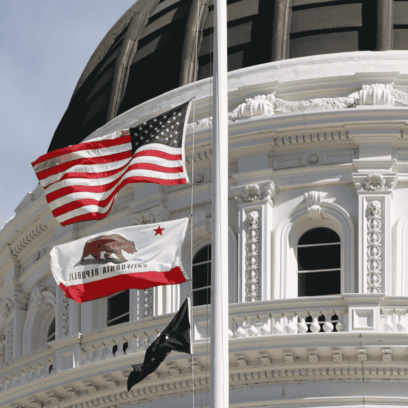New US Bill May Set Tariffs on Pollution


As climate-related disclosure and mitigation requirements continue to evolve, understanding the latest regulatory landscape is essential for US companies. In this webinar, we cut through the jargon to provide clear insights into emerging climate-related requirements, breaking down two key federal proposals and one EU regulation impacting some US-based companies. Join us to stay informed and prepared for what’s ahead in climate compliance.

🌍 Carbon markets can feel overwhelming—fragmented data, limited transparency, and conflicting advice make it hard to know where to start. In this webinar, our experts give a clear, practical introduction to the VCM.
Here’s what businesses need to know about the Foreign Pollution Fee Act (FPFA).
A new bill in US Congress, the Foreign Pollution Fee Act (FPFA) of 2025, could soon reshape how companies think about emissions, global trade, and even the price of everyday products. The proposal would place a fee on imported goods based on how much pollution is created during their production. In simple terms: the more emissions produced in the process, the higher the cost for business. The bill aims to reward US manufacturers who follow stricter environmental rules, while pushing international companies to clean up their operations if they want to stay competitive.
A Sign of What’s to Come
This is part of a shift: making pollution a cost that businesses can’t ignore. Governments around the globe are creating new rules that put a price on carbon, whether through taxes, import fees, or mandatory emissions reporting. For example, the EU Carbon Border Adjustment Mechanism (CBAM), will require companies importing goods like steel, cement, and aluminum into the EU will need to pay a fee based on the carbon emissions created during production.
This signals a future where businesses will need to account for the emissions attached to every product they buy, sell, or—in this case—move across borders. Companies that once viewed cutting emissions as a long-term climate goal will increasingly face short-term financial pressure to act.
What Does this Mean for Businesses?
For businesses of all sizes, this proposed legislation signals a major shift in how carbon emissions are becoming a cost of doing business. The table below shows which products specifically would be covered in this bill, if it were to pass.
FIGURE 1: Products covered in the Foreign Pollution Fee Act (FPFA)
Category | Examples | Why It’s Included |
| Metals | Steel, Aluminum | High-emissions industries; often produced using coal-intensive processes abroad. |
| Construction Materials | Cement, Glass | Energy-intensive production and significant carbon footprint. |
| Fertilizers | Ammonia-based fertilizers | Often derived from fossil fuels like natural gas. |
Hydrogen | Hydrogen used as industrial feedstock or fuel | Emissions depend heavily on production method (e.g., grey vs. green hydrogen). |
Solar Components | Panels, wafers, cells | Concerns over dirty supply chains (especially coal-based manufacturing in Asia). |
Battery Inputs | Graphite, lithium, cobalt, nickel | Extracted and processed with large carbon (and ethical) footprints abroad. |
Affected companies that fail to measure and manage their supply chain emissions could face higher import fees, making their products less competitive in the US market.
The proposed fee structures include both a base rate and a variable rate. The variable rate is determined by how much more pollution was created compared to making the same product in the US. This may push businesses to rethink their suppliers, production methods, and even product designs to reduce emissions. Reducing emissions will move from “nice to have” to a business necessity, and companies that adapt earlier will have more flexibility and fewer financial shocks down the line.
This bill also highlights how closely climate action and business reputation are now linked. From consumers to shareholders, more people are paying attention to how companies handle their carbon footprint, and legislation like this could raise expectations even higher. Companies that proactively measure, reduce, and offset their emissions will not only avoid penalties but also strengthen their brand reputation in an increasingly carbon-conscious market.
A Strategic Approach to Emissions Reduction
The momentum behind the FPFA is creating an opportunity for businesses to rethink their supply chains and operations while unlocking long-term financial resilience.
Rather than relying on one off solutions, businesses should take a structured approach by developing a comprehensive decarbonization roadmap. A plan that maps out how to systematically reduce emissions across the entire value chain.
A strong roadmap begins with a deep understanding of the company’s full emissions profile, including both direct (Scope 1 and 2) and indirect (Scope 3) emissions. Establishing a clear baseline allows businesses to identify the biggest opportunities for reductions and avoid costly surprises as carbon regulations evolve.
From there, specific, actionable steps can guide decarbonization:
- Switching to lower-carbon suppliers and materials
- Improving operational and production efficiency
- Redesigning products to reduce lifecycle emissions
- Exploring process electrification and clean energy sourcing
- Engaging in supplier collaboration to reduce upstream emissions
This type of structured approach ensures businesses aren’t just reacting to new regulations but are actively reducing risk, improving resilience, and staying competitive in an increasingly carbon-conscious economy.
Can Carbon Removals be the Key?
Even with the most ambitious decarbonization efforts, some emissions will be unavoidable in the short term, and that is where carbon removals come into play.
While the FPFA doesn’t directly mention carbon removals in the headline, it does something significant: it recognizes certified carbon removals as a valid way for companies to reduce the pollution fees tied to imported products.
Carbon removals are solutions designed to take carbon dioxide (CO2) out of the atmosphere. These can include natural methods, like reforestation, or advanced technologies that capture and permanently store carbon. Under the proposed law, removals must take place in the country where the emissions occur, and they must be verifiable, measurable, and properly accounted for. Once certified, these removals can be used to balance out a company’s emissions and lower the pollution fees tied to their imported products.
For businesses, this creates a new lever for managing costs and compliance while supporting global climate goals. Combining reductions and removals allows companies to act now, rather than waiting for low-emission technologies to mature.
The Bottom Line
The FPFA is a clear sign: pollution may soon come with a price tag. Companies that act early by reducing emissions through structured decarbonization roadmaps and addressing residual emissions with carbon removals will be better positioned to manage risk, maintain competitiveness, and lead in a carbon-accountable global economy.
Beyond compliance, taking action now signals leadership. It helps build brand trust, meet evolving customer expectations, and stay ahead of emerging regulations.
CarbonBetter helps businesses measure, reduce, and offset emissions, making climate action part of a strong business strategy. Contact us today to get started.
The FPFA is a proposed US law that would place fees on imported products based on the pollution created during their production. It aims to encourage cleaner manufacturing worldwide and level the playing field for US companies that already meet stricter environmental standards.
Any business that imports carbon-intensive products into the US — especially industries like steel, cement, aluminum, and manufacturing — could be impacted. Companies will need to understand the emissions footprint of their supply chain to avoid unexpected costs.
Yes. Companies can lower their pollution fees by following a structured decarbonization roadmap and investing in certified carbon removals.
A decarbonization roadmap helps businesses systematically reduce emissions across operations and supply chains. For unavoidable emissions, carbon removals like reforestation or carbon capture can help offset remaining pollution and reduce fees under the new law.
The FPFA is still a proposed bill, so timelines could shift, but if passed, the law would likely phase in over the next few years. Preparing early can help businesses avoid last-minute disruptions, manage financial risk, and strengthen both their climate strategy and supply chain resilience.


